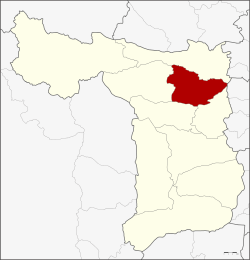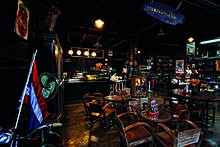Sam Chuk District
| Sam Chuk สามชุก | |
|---|---|
| Amphoe | |
 Amphoe location in Suphan Buri Province | |
| Coordinates: 14°45′19″N 100°5′41″E / 14.75528°N 100.09472°ECoordinates: 14°45′19″N 100°5′41″E / 14.75528°N 100.09472°E | |
| Country | Thailand |
| Province | Suphan Buri |
| Seat | Sam Chuk |
| Area | |
| • Total | 355.9 km2 (137.4 sq mi) |
| Population (2013) | |
| • Total | 54,950 |
| • Density | 163.6/km2 (424/sq mi) |
| Time zone | UTC+7 (ICT) |
| Postal code | 72130 |
| Geocode | 7208 |
Sam Chuk (Thai: สามชุก, pronounced [sǎːm t͡ɕʰúk]) is a district (amphoe) in the northern part of Suphan Buri Province, central Thailand.
History
Originally the district name was Nang Buat. In 1911 when the government separated part of Nang Buat District and established Doem Bang District, it also moved the district office to Ban Sam Pheng, Tambon Sam Chuk. In 1939 the district name was changed to Sam Chuk as the central tambon.[1]
Geography
Neighboring districts are (from the south clockwise) Si Prachan, Don Chedi, Nong Ya Sai and Doem Bang Nang Buat of Suphan Buri Province, and Sawaeng Ha of Ang Thong Province.
The main water resource of Sam Chuk is the Tha Chin river or Suphan River.
SamChuk's 100-year-old market


Thailand's Sam Chuk community and Old Market District along the Tha Chin River not far from Bangkok, northwest of the Thai capital in Suphan Buri Province—is a bit of old China in once rural Siam. Witness to a disappeared way of life, the distinctive river and canal-side community was recently granted an Award of Merit in the 2009 United Nations Educational, Scientific and Cultural Organization (UNESCO) Asia-Pacific Heritage Awards for Culture Heritage Conservation.
A century ago, Sam Chuk was a renowned centre for waterborne trade and commerce, when rivers and canals were Siam’s main mode of transport. But today, times have changed, and the old town’s way of living has changed accordingly. The negative impact on its survival was heightened when roads were cut through the old community, reducing the need for and importance of water transport, and cutting off easy access to places that had once been central.
Passed by the new ways of life, SamChuk was deteriorating, falling into ruin. Old wooden houses and buildings were decaying as a result of termites and accumulated damage from rain and old age.
Realising the changes taking place, local residents formed a SamChuk Market Conservation Committee. Rather than pulling down the old buildings, they organised to preserve what they received from their ancestors and restored 19 local buildings, adapting the old style architecture described in Thai as Khanompang Khing (ginger bread) style, into a contemporary market, welcoming to traditionalists and those with new style taste as well.
Local homes have been converted into welcoming shops, cafes and museums, where visitors can get a glimpse – touch, taste and feel the past – a sense of what it was like a century ago when the market was really bustling.
As a venue for its mouthwatering rare traditional dishes and old-style desserts, Samchuk Market has attracted visitors and habitués from all walks of life, particularly those Thais who are known for crossing cities or towns just in order to taste local delicacies.[2]
Sam chuk community has an attractive old market because all merchants have a friendly to invite and service travelers to visit there and they inform the history of Samchuk.There are many sightseeing at samchuk 100 years old market that you should not miss to visit and take some photos as:
-Udomchok Hotel ( โรงแรมอุดมโชค ) the old classic hotel in this market .Although out of service now but they open to show inside of the service room.And there are the old style coffee shop at the first floor. Travelers can take some photo that back to the past . -Silapa Thammachart photo shop ( ร้านศิลปธรรมชาติ ) – the classic & conservative photo shop in Samchuk market.More than 55 years from unless the electricity service, they have to use the sunlight for record the photos. And now the oldest daughter of the owner look after this shop.She still use the first camera to photo all customer.It’s look classic process that you cannot find out in the digital life . -Bann khun chumnongjeenarak museum (พิพิธภัณฑ์บ้านขุนจำนงจีนารักษ์) where show a miniature of Samchuk market and many antique for learn the old local life in Samchuk market.
Samchuk Market has a lot of small shops along a walkway in market where service a delicious Thai & Chinese food and local consumer product.[3]
Administration
Central administration
Sam Chuk is divided into seven sub-districts (tambon), which are further subdivided into 68 administrative villages (muban).
| No. | Name | Thai | Villages | Pop.[4] |
|---|---|---|---|---|
| 1. | Yan Yao | ย่านยาว | 9 | 8,140 |
| 2. | Wang Luek | วังลึก | 15 | 12,366 |
| 3. | Sam Chuk | สามชุก | 6 | 10,783 |
| 4. | Nong Phak Nak | หนองผักนาก | 8 | 8,443 |
| 5. | Ban Sa | บ้านสระ | 10 | 5,915 |
| 6. | Nong Sadao | หนองสะเดา | 10 | 5,132 |
| 7. | Krasiao | กระเสียว | 10 | 4,171 |
Local administration
There is one sub-district municipality (thesaban tambon) in the district:
- Sam Chuk (Thai: เทศบาลตำบลสามชุก) consisting of sub-district Sam Chuk and parts of sub-districts Yan Yao and Krasiao.
There are six sub-district administrative organizations (SAO) in the district:
- Yan Yao (Thai: องค์การบริหารส่วนตำบลย่านยาว) consisting of parts of sub-district Yan Yao.
- Wang Luek (Thai: องค์การบริหารส่วนตำบลวังลึก) consisting of sub-district Wang Luek.
- Nong Phak Nak (Thai: องค์การบริหารส่วนตำบลหนองผักนาก) consisting of sub-district Nong Phak Nak.
- Ban Sa (Thai: องค์การบริหารส่วนตำบลบ้านสระ) consisting of sub-district Ban Sa.
- Nong Sadao (Thai: องค์การบริหารส่วนตำบลหนองสะเดา) consisting of sub-district Nong Sadao.
- Krasiao (Thai: องค์การบริหารส่วนตำบลกระเสียว) consisting of parts of sub-district Krasiao.
Travel to 100-years-old market
Travel by car: From Bangkok to 100-years-old market is through Bang Bua Thong district of Nonthaburi province to Suphan Buri city. The distances are around 107 kilometers and then go to the entrance of Samchuk market which is close to Lotus department store. The market is near Samchuk district office.[5]
References
- ↑ พระราชกฤษฎีกาเปลี่ยนนามอำเภอ กิ่งอำเภอ และตำบลบางแห่ง พุทธศักราช ๒๔๘๒ (PDF). Royal Gazette (in Thai). 56 (0 ก): 354–364. April 17, 1939.
- ↑ "UNESCOBKK".
- ↑ "Samchuk Market". Tourism Authority of Thailand (TAT). Retrieved 6 May 2018.
- ↑ "Population statistics 2013" (in Thai). Department of Provincial Administration. Retrieved 2014-10-04.
- ↑ "การเดินทางมาสามชุกตลาดร้อยปี". Archived from the original on 2017-04-19. Retrieved 2017-04-18.
External links
| Wikimedia Commons has media related to Sam Chuk District. |